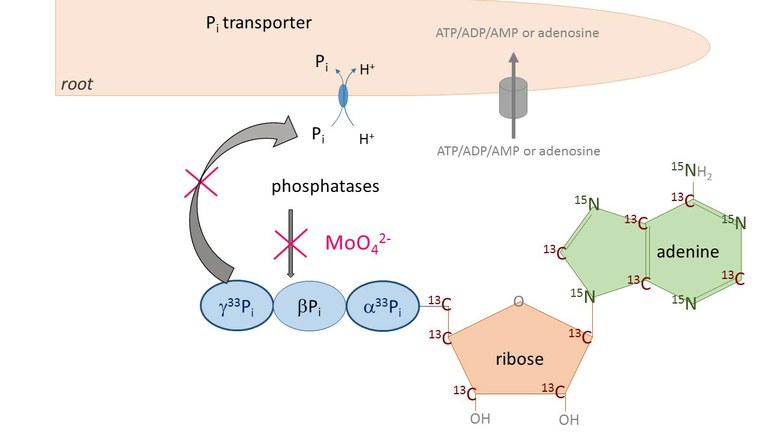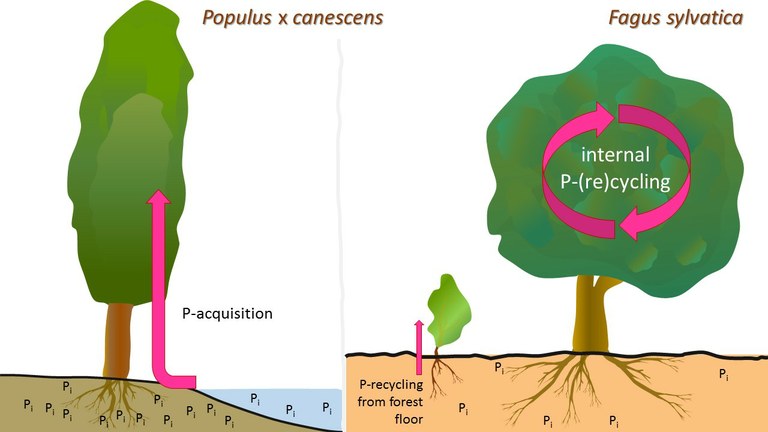current research
Topic: Interaction between nitrogen and phosphorus nutrition
During industrialization, N emissions from anthropogenic sources such as motor vehicles, fossil fuel combustion and excess N fertilization to agricultural systems resulted in an enlarged N deposition to natural ecosystems such as temperate forests. This leads to the conversion of previously N-limited forest ecosystems to N saturated systems. Furthermore, there is a strong evidence that N-deposition increased foliar N:P ratios in numerous plant species which will affect both, the N and P nutrition of trees. The increasing input of N into temperate forest ecosystems may result in (i) decreased foliar P contents due to enhanced growth that will (ii) lead to P deficiency and may influence the P nutrition of beech and poplar in different ways. These research topics were investigated during the second phase of the SPP 1685 (2016-2019) ‘Environmental and intrinsic regulation of phosphorus acquisition, partitioning, storage, and mobilization in beech and poplar trees’. (https://www.ecosystem-nutrition.uni-freiburg.de/Projecte%202/project_dippold_2)
The conclusion for Populus x canescens was: ‘If P reserves are present, P compounds were mobilized from the stem tissues, bark and wood, which compensate for an enhanced P demand at high N load. However, this compensation is limited upon prolonged excess N deposition and will lead to P limitation for growth in the long run’ (Netzer et al., 2019).
Topic: Researches on the P nutrition of trees
Phosphorus (P) is an essential macronutrient for plant growth and development due to its central function in energy metabolism, inheritance and metabolic control. In many ecosystems, plant available soil-P gets limited by soil aging. Thus, it was assumed that the P nutrition strategy of ecosystems depends on the soil type and paedogenesis. The P nutrition of ecosystems combines the soil-P cycle, soil-plant interactions and the P nutrition of plants. These research topics are all investigated within the SPP 1685 (https://www.ecosystem-nutrition.uni-freiburg.de/ueberspp1685). The research focus on tree internal P nutrition was investigated during the first phase (2013-2016) of the SPP 1685 in the joint project entitled: ‘Environmental and intrinsic regulation of phosphorus acquisition, partitioning, storage, and mobilization in beech and poplar tree’ (https://www.ecosystem-nutrition.uni-freiburg.de/projects/projekt_rennenberg). Different P nutrition strategies of trees fit well to the respective growth habitat of two tree species; Fagus sylvatica which can grow on P-poor soils and of the fast-growing tree species Populus x canescens with unrestricted P-availability in their main growth habitat of floodplains.
P uptake takes place as phosphate (Pi) either from inorganic Pi pools in the aqueous phase of the soil or after cleavage of phosphate from organic-bound phosphate. Cleavage of Pi from ATP by enzymes commonly present in the rhizosphere, such as extracellular acid phosphatases, ecto-apyrases and/or nucleotidases, prior ADP/AMP/adenosine uptake is highly probable (Scheerer et al., 2019). Uptake of P from nucleotides was investigated with labelled ATP, with 13C at the ribose and base, with 15N at the base only and with 33P at the α or γ position of the phosphate (Scheerer et al., 2019) (see figure 1). Although uptake of ATP/ADP/AMP cannot be excluded, uptake of the nucleoside adenosine without further breakdown into its constituent ribose and adenine is indicated. Based on the 33P, 13C, and 15N uptake rates calculated as equivalents of ATP the ‘pro and contra’ for the uptake of nucleotides and nucleosides is discussed in Scheerer et al., (2019). However, it is highly probable that there are differences between the type of the soil as well as the pH of the soil.

Figure 1: Diagram of ATP and the labelling postions of 13C, 15N and 33P. Molybdate was applied as a
common acid phosphatase inhibitor to prevent cleavage of the γPi and βPi unit of the ATP molecule. Phosphate (Pi) is take up by roots via phosphate transporters. For details see Scheerer et al., (2019).
P nutrition strategies differ between beech and poplar. Fagus sylvatica forests of Central Europe have been established on P-limited soils. This requires an efficient P-nutrition strategy to sustain sufficient P for growth and development during annual growth, which results in similar biomass increment at forests stands with high and low soil-P availability. Adult beech trees show P storage and P remobilization in branches in form of inorganic phosphate (Pi) and organic-bound phosphate (Porg) in the bark and wood (Netzer et al., 2017; 2018b). In addition, dormant leaf buds build a ‘start-up capital’ in form of phospholipids (Netzer et al., 2017; 2018b). Hence, P recycling is the P nutrition strategy of adult beech trees at poor P nutrition (figure 2, right site). In contrast, beech offspring did not exhibit any P storage in the stem bark and wood but accumulated P in dormant leaf buds which allows fast development of leaves in spring. Nevertheless, the P nutrition strategy of beech offspring has been characterized by P acquisition.
The P nutrition of Populus x canescens markedly differs from that of European beech growing at low soil-P availability (Netzer et al. 2018a, Watanabe et al., 2018), which was mainly due to the absence of internal P (re)cycling during the annual growth that is indicated by the lack of establishing P storage pools in twig bark and wood during dormancy. Thus, a strategy to economize P nutrition and to prevent P losses has not been developed and the P nutrition of poplar can be characterized as P acquisition strategy (see figure 2, left site). The latter is not surprising when the main growth habitat with sufficient or even surplus in soil-P is considered for poplar.

Figure 2: The P nutrition strategy of Populus x canescens (left site) and of Fagus sylvatica offspring and adutls (right site). Figure adapted from Krüger et al., (2020).

